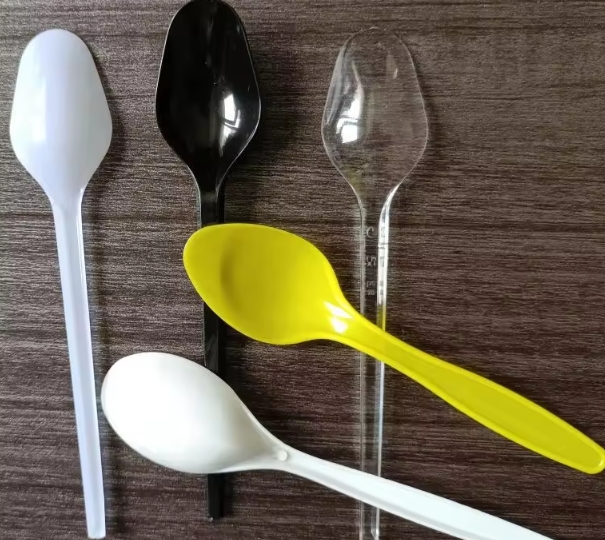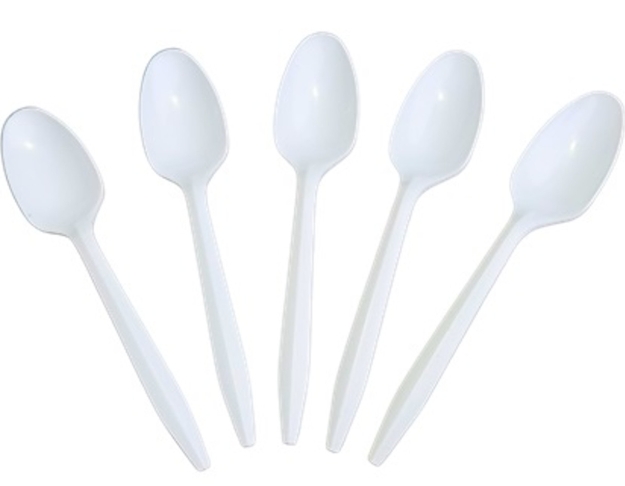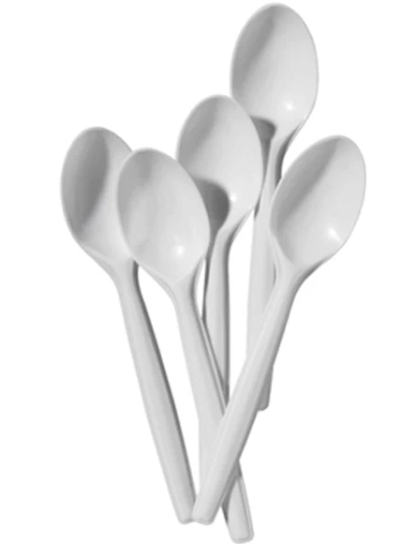
Content Menu
● Overview of the Disposable Plastic Spoon Market
● Key Factors Affecting Disposable Plastic Spoon Price
>> 1. Raw Material Costs
>> 2. Manufacturing Process and Technology
>> 3. Product Specifications and Quality
>> 4. Environmental Regulations and Sustainability Trends
>> 5. Market Demand and Application
>> 6. Geographic Factors and Logistics
● Market Dynamics Influencing Disposable Plastic Spoon Price
>> Convenience vs. Environmental Concerns
>> Competition and Product Innovation
>> Economic and Lifestyle Factors
● Manufacturing Plastic Spoons: Cost Components and Pricing
● Future Trends Impacting Disposable Plastic Spoon Price
● Conclusion
● FAQ
>> 1. What are the main raw materials used in manufacturing disposable plastic spoons?
>> 2. How do environmental regulations affect the price of disposable plastic spoons?
>> 3. Why do colored or biodegradable plastic spoons cost more than plain white ones?
>> 4. How does manufacturing scale impact the disposable plastic spoon price?
>> 5. What trends are shaping the future pricing of disposable plastic spoons?
● Citations:
Disposable plastic spoons are ubiquitous in the food service industry, catering services, events, and households worldwide. Their convenience, hygiene, and low cost make them a staple for single-use cutlery. However, the disposable plastic spoon price varies widely depending on several factors ranging from raw material costs to environmental regulations. This article explores the key elements influencing the price of disposable plastic spoons, market dynamics, manufacturing processes, and emerging trends shaping the industry.

Overview of the Disposable Plastic Spoon Market
The global disposable spoon market is robust and growing, valued at approximately $4 billion with an annual production exceeding 150 billion units. Plastic spoons dominate the market due to their affordability and ease of production, especially in developing economies where demand for convenient and hygienic food service products is rising rapidly[1][4].
The market is segmented by material type (plastic, wood, biodegradable materials), application (restaurants, supermarkets, homes), and geography. Asia-Pacific leads in production and consumption, driven by urbanization and the expansion of food delivery and quick-service restaurants[1][4].
Key Factors Affecting Disposable Plastic Spoon Price
1. Raw Material Costs
The primary raw material for disposable plastic spoons is plastic resin, commonly polypropylene (PP) and polystyrene (PS). The price of these resins fluctuates based on global oil prices, supply chain conditions, and demand in other plastic sectors. Polypropylene is favored for its durability and heat resistance, while polystyrene is cheaper but less heat tolerant[3][5].
- Polypropylene pellets cost around Rs. 35/kg in India, making up a significant portion of production costs[3].
- Plasticizers and packaging materials also add to the raw material expenses.
Changes in raw material prices directly impact the disposable plastic spoon price, especially since plastic spoons are low-margin products[3][5].
2. Manufacturing Process and Technology
Disposable plastic spoons are typically manufactured using injection molding machines. The efficiency, scale, and automation level of the production unit influence costs. Higher capacity plants with advanced machinery can lower per-unit costs due to economies of scale[3].
- Production capacity and utilization rates affect cost efficiency. For example, a plant producing 300,000 packets annually can reduce costs with higher utilization[3].
- Energy consumption (power requirement ~30 HP) and labor costs also factor into pricing[3].
3. Product Specifications and Quality
The size, thickness, color, and design of the spoon affect material usage and production complexity.
- Colored or biodegradable plastic spoons generally cost more than plain white versions due to additional materials and processing[2].
- Spoons designed for hot foods require more durable plastics like polypropylene, increasing costs compared to polystyrene spoons used for cold foods[5].
4. Environmental Regulations and Sustainability Trends
Increasing environmental awareness and government regulations on single-use plastics are reshaping the market.
- Many regions impose bans or taxes on conventional plastic spoons, pushing manufacturers to develop biodegradable or compostable alternatives made from wood, bamboo, or bioplastics[1][4].
- These eco-friendly options typically have higher production costs, reflecting in their disposable plastic spoon price.
- Innovation in bioplastics aims to balance cost and sustainability, but traditional plastic spoons remain cheaper for now[1][4].
5. Market Demand and Application
Demand fluctuations in various sectors influence pricing.
- The food service industry, especially fast-food chains and online food delivery, drives high-volume demand, enabling bulk pricing discounts[1][4].
- Event supplies and retail packaging also affect price points due to varying order sizes and customization needs[2].
6. Geographic Factors and Logistics
Regional production costs, labor rates, and transportation expenses contribute to price differences.
- Asia-Pacific, as the largest producer, benefits from lower manufacturing costs, making spoons cheaper in this region[1][4].
- Import/export duties and shipping costs affect prices in North America and Europe, where environmental regulations are stricter, and demand for sustainable products is higher[1][4].

Market Dynamics Influencing Disposable Plastic Spoon Price
Convenience vs. Environmental Concerns
The convenience and hygiene benefits of disposable plastic spoons sustain their demand. However, growing environmental concerns and consumer backlash against plastic waste are pressuring manufacturers to innovate and adopt greener alternatives[1][4].
Competition and Product Innovation
The market is highly competitive with many players ranging from local manufacturers to global brands. Companies compete on price, quality, and sustainability credentials[1][4].
- Innovations in materials science, such as biodegradable plastics with enhanced durability, are emerging to meet regulatory and consumer demands without drastically increasing costs[1][4].
- Product differentiation through improved ergonomics and heat resistance also influences pricing strategies[1].
Economic and Lifestyle Factors
Rising disposable incomes and changing lifestyles, especially in developing countries, increase consumption of ready-to-eat foods and disposable cutlery, supporting market growth and price stability[1][4].
Manufacturing Plastic Spoons: Cost Components and Pricing
A typical plastic spoon manufacturing unit involves:
- Raw materials: polypropylene pellets, plasticizers, and packaging.
- Machinery: injection molding machines and auxiliary equipment.
- Labor and utilities: skilled operators and energy consumption.
- Overheads: rent, maintenance, and administrative expenses.
For example, a project with a production capacity of 300,000 packets per year (each packet containing 100 spoons) may have a total project cost of around Rs. 20.44 lakhs (~$25,000), with raw material costs comprising the largest share (~Rs. 61.7 lakhs annually)[3].
The disposable plastic spoon price per piece can range from as low as ₹0.11 (approx $0.0015) for basic picnic spoons to ₹2.25 ($0.03) or more for biodegradable or colored spoons[2].
Future Trends Impacting Disposable Plastic Spoon Price
- Shift to Biodegradable Materials: Increasing adoption of eco-friendly spoons will raise average prices but may open new market segments[1][4].
- Technological Advancements: Improved manufacturing efficiency and new materials may reduce costs over time[1][5].
- Regulatory Pressure: Stricter bans on single-use plastics will reduce demand for traditional plastic spoons, potentially increasing prices due to lower volumes and higher compliance costs[1].
- Consumer Awareness: Growing preference for sustainable products may justify premium pricing for biodegradable spoons[1][4].
Conclusion
The disposable plastic spoon price is influenced by a complex interplay of raw material costs, manufacturing technology, product specifications, environmental regulations, market demand, and geographic factors. While plastic spoons remain the most affordable option for single-use cutlery, rising environmental concerns and regulatory pressures are driving a gradual shift towards sustainable alternatives, which tend to be more expensive. Manufacturers must balance cost-efficiency with innovation and sustainability to remain competitive in a dynamic market landscape. Understanding these factors is essential for buyers, suppliers, and manufacturers to navigate pricing trends effectively.

FAQ
1. What are the main raw materials used in manufacturing disposable plastic spoons?
Disposable plastic spoons are primarily made from polypropylene and polystyrene resins. Polypropylene is preferred for its durability and heat resistance, while polystyrene is cheaper but less heat tolerant[3][5].
2. How do environmental regulations affect the price of disposable plastic spoons?
Regulations limiting single-use plastics increase production costs by pushing manufacturers to adopt biodegradable or compostable materials, which are more expensive than traditional plastics[1][4].
3. Why do colored or biodegradable plastic spoons cost more than plain white ones?
Colored spoons require additional dyes and processing, while biodegradable spoons use specialized eco-friendly materials, both of which increase manufacturing complexity and costs[2][4].
4. How does manufacturing scale impact the disposable plastic spoon price?
Larger production volumes and higher utilization rates lower per-unit costs due to economies of scale, making spoons cheaper when produced in bulk[3].
5. What trends are shaping the future pricing of disposable plastic spoons?
Trends include a shift towards biodegradable materials, technological advancements in production, stricter environmental regulations, and increasing consumer demand for sustainable products, all influencing price dynamics[1][4].
Citations:
[1] https://www.marketreportanalytics.com/reports/disposable-spoon-68928
[2] https://dir.indiamart.com/impcat/disposable-plastic-spoon.html
[3] https://www.kviconline.gov.in/pmegp/pmegpweb/docs/commonprojectprofile/PlasticSpoons.pdf
[4] https://www.cognitivemarketresearch.com/plastic-spoon-market-report
[5] https://www.alibaba.com/showroom/manufacturing-plastic-spoon.html
[6] https://emeraldecovations.com/2024/08/uncovering-the-environmental-impact-of-plastic-spoons/
[7] https://www.anchenggy.com/blog/disposable-spoons-comparison.html
[8] https://www.scmp.com/news/hong-kong/health-environment/article/3251624/hong-kong-restaurants-grapple-impending-ban-plastic-some-saying-it-costs-too-much-go-green
[9] https://www.alliedmarketresearch.com/disposable-cutlery-market-A31543
[10] https://www.epd.gov.hk/epd/sites/default/files/epd/english/environmentinhk/waste/pub_consult/files/tableware-con-doc-en.pdf
[11] https://www.hktvmall.com/hktv/en/main/search?q=%3Arelevance%3Astreet%3Amain%3Acategory%3AAA18208540001
[12] https://pmarketresearch.com/hc/plastic-spoons-market/
[13] https://dir.indiamart.com/impcat/disposable-plastic-spoon/length-5-inch-q15019649/
[14] https://www.epd.gov.hk/epd/sites/default/files/epd/english/environmentinhk/waste/pub_consult/files/tableware-leaflet-en.pdf
[15] https://www.alibaba.com/countrysearch/CN/disposable-plastic-spoon.html
[16] https://www.justdial.com/Moradabad/Plastic-Spoon-Manufacturers/nct-10376409
[17] https://www.businessresearchinsights.com/market-reports/disposable-plastic-spoon-and-fork-market-103776
[18] https://www.scmp.com/news/hong-kong/health-environment/article/3283132/restaurants-hit-higher-costs-hong-kong-readies-penalties-plastic-cutlery
[19] https://www.zauba.com/import-plastic+spoon/hs-code-3924-hs-code.html
[20] https://www.buerkle.de/en/laboplast-r-spoon-disposable_p5378-0011

















